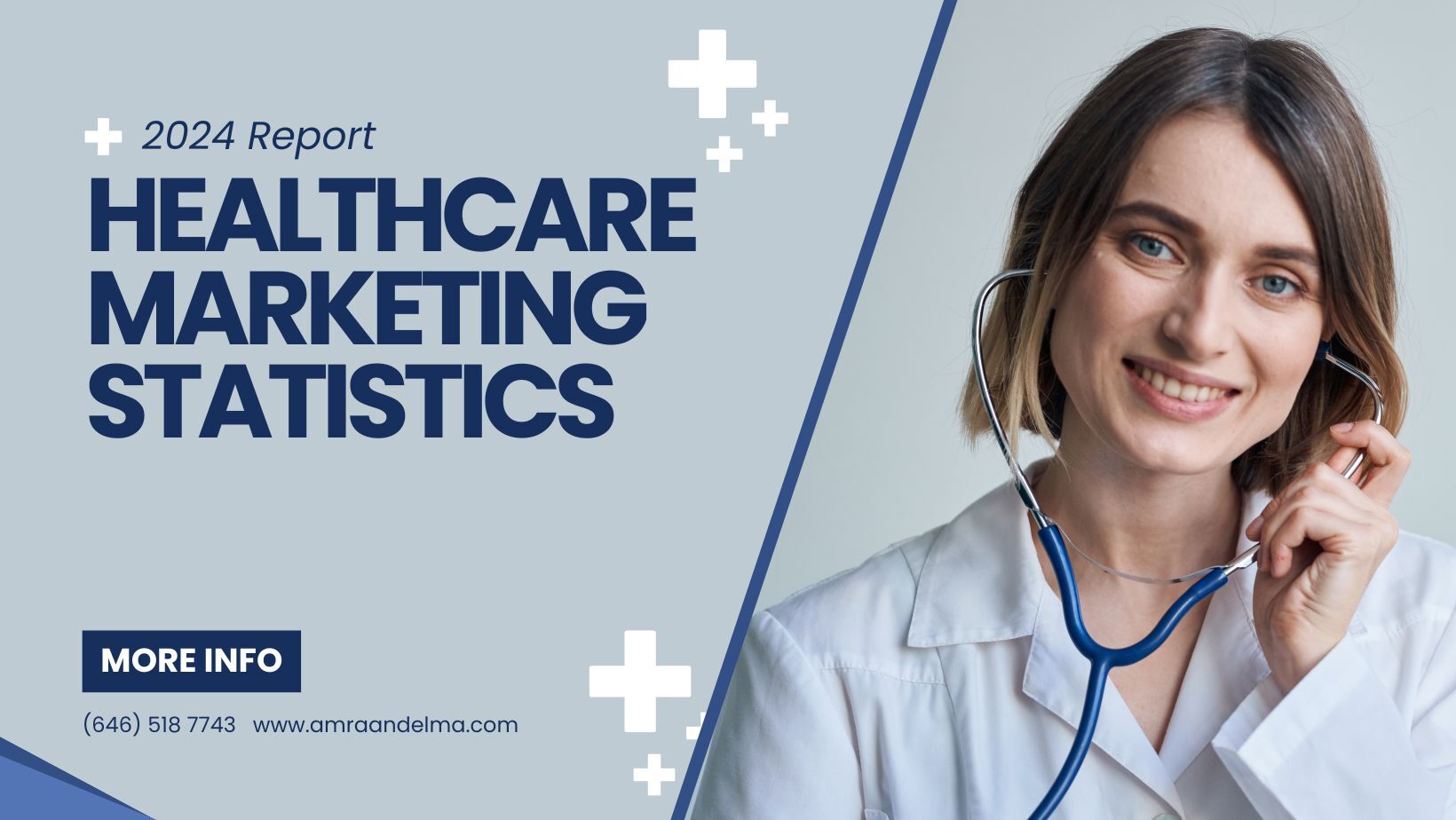
03 May TOP HEALTHCARE MARKETING STATISTICS IN 2024
The healthcare landscape is undergoing a transformative evolution, driven by a convergence of technological advancements, changing consumer behaviors, and regulatory reforms. Statistics reveal the seismic shift towards digital health solutions, with the global wearable healthcare devices market projected to reach USD $68.4 billion by 2032, representing a compound annual growth rate (CAGR) of 8.6%. Additionally, the wearable electronics market is forecasted to expand from US$32.5 billion in 2022 to US$173.7 billion by 2030, reflecting a robust CAGR of 23.3% over the analysis period. Concurrently, studies indicate that approximately 75% of patients rely on online reviews as their initial step when seeking new healthcare providers, underscoring the growing influence of digital channels in healthcare decision-making. Against this backdrop, the global healthcare industry stands at the cusp of unprecedented opportunities and challenges, as stakeholders navigate the complexities of an increasingly interconnected and digitized healthcare ecosystem.
Below, we at Amra and Elma, a top healthcare marketing agency, compiled a list of top 20 healthcare marketing statistics:
Healthcare Marketing Statistics (Editor’s Choice)
- Global Healthcare Advertising Market to Reach USD $60.26 Billion by 2031
- 9% of adults in the United States utilized the Internet to search for health or medical information
- An estimated 7% of all Google search queries on the platform are health-related
- 82.8% of US-based patients search engines to find a healthcare provider
- 75% of patients use online reviews when deciding which healthcare provider to choose
20 Top Healthcare Marketing Statistics and Trends in 2023
Healthcare Marketing Statistics #1: ABC Forecast: Global Healthcare Advertising Market to Reach USD $60.26 Billion by 2031.
According to ABC, in 2023, the global healthcare advertising market reached a value of USD $39.57 billion, and projections suggest it will expand to USD $60.26 billion by 2031. This growth is expected to occur at a compound annual growth rate (CAGR) of approximately 5.40% throughout the forecast period. Several factors contribute to the expansion of the global healthcare advertising market. One significant driver is the heightened competition among pharmaceutical companies and healthcare entities, prompting increased spending on advertising to establish robust brand identities. Through advertising, healthcare companies can showcase their innovative products and services, communicate unique value propositions, and cultivate consumer trust. Moreover, advertising serves as a vital tool for informing both consumers and healthcare professionals about the benefits of products, particularly in light of advancements in medical technology and healthcare solutions. Given the dynamic nature of the healthcare sector, strategic investments in advertising will be crucial for sustaining growth and achieving success for businesses operating within this rapidly evolving market.
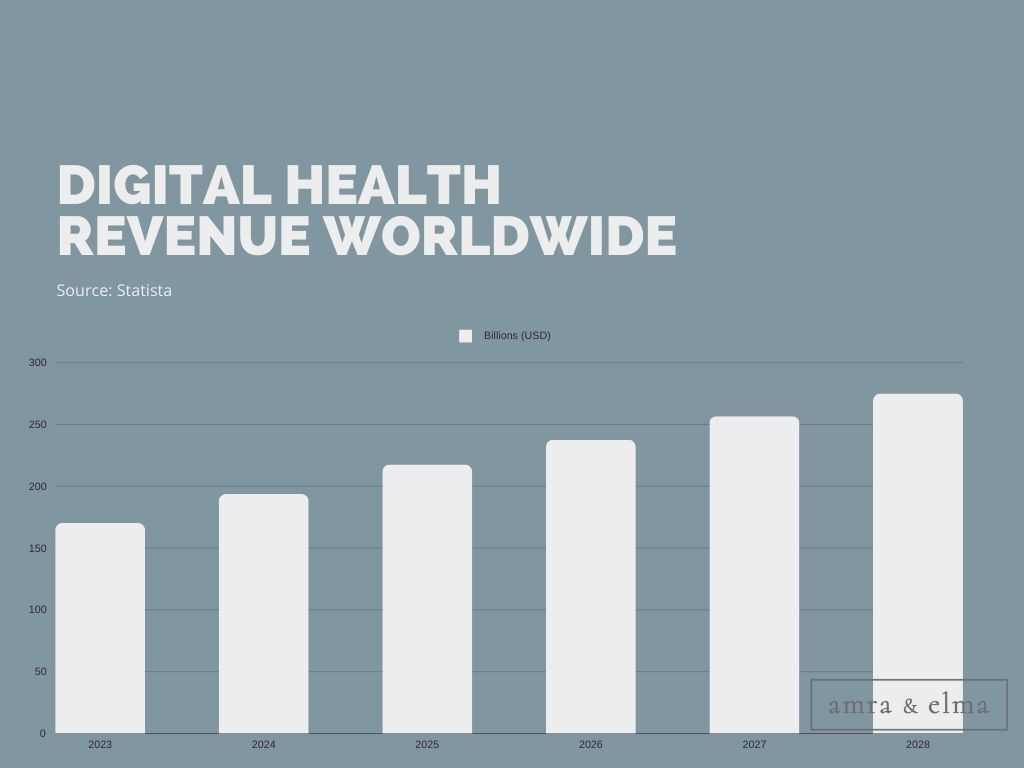
Healthcare Marketing Statistics #2: 59% of adults in the United States utilized the Internet to search for health or medical information.
Research conducted by the National Center for Health Statistics revealed that 59% of adults in the United States utilized the Internet to search for health or medical information, 42% utilized it for communication with a doctor or doctor’s office, and 46% utilized it to access medical test results. Additionally, according to Google, health-related searches constitute approximately 7% of all Google searches, with search engines driving three times more visitors to hospital sites compared to non-search sources. Furthermore, there are approximately 70,000 health-related searches conducted per minute, every day. CDC research indicates that 74% of all U.S. adults use the Internet, and 61% have sought health or medical information online.
In conclusion, the widespread use of the Internet for health-related purposes underscores the pivotal role of digital platforms in healthcare information dissemination and communication. With a significant portion of the population turning to online resources for medical information, communication with healthcare providers, and access to test results, it is evident that digital channels play a crucial role in shaping patient behavior and engagement. Moreover, the staggering volume of health-related searches on platforms like Google highlights the immense demand for accessible and reliable health information online. As technology continues to evolve and healthcare delivery becomes increasingly digitized, it is imperative for healthcare organizations to leverage digital strategies effectively to meet the needs of patients and consumers in an ever-changing landscape.
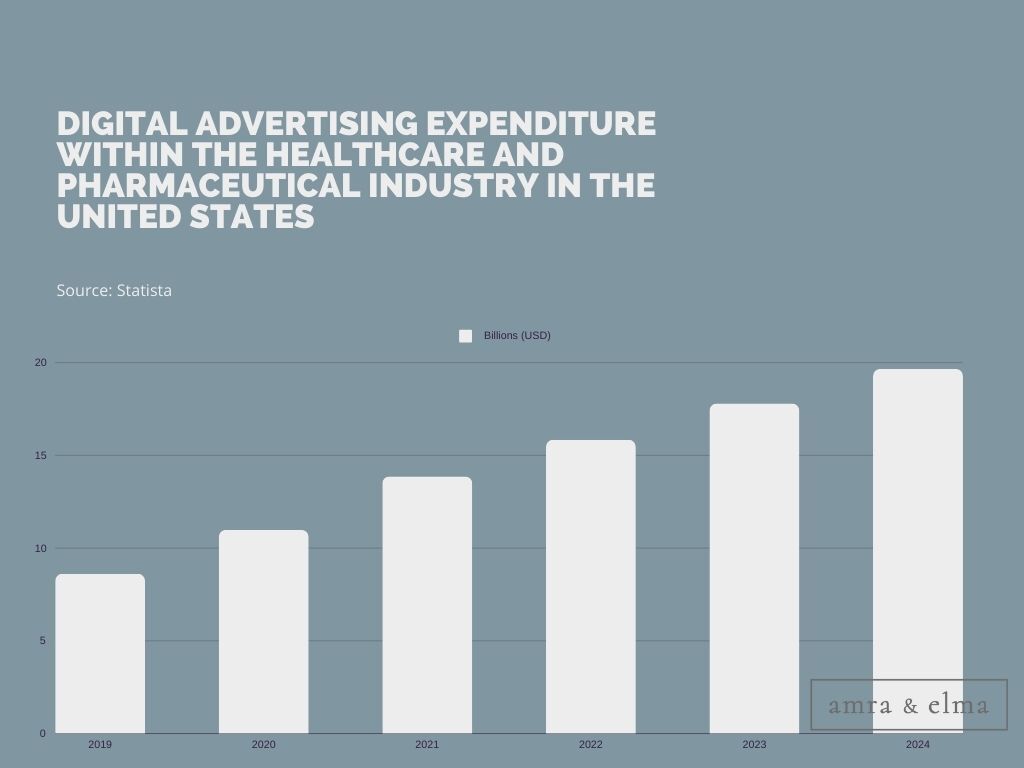
Healthcare Marketing Statistics #3: The forecast predicts a continuous rise in global healthcare spending from 2024 to 2029, reaching a total increase of $3.4 trillion USD (+29.33 percent) over the period.
According to Statista, The forecast indicates a steady increase in the global current health expenditure as a share of the GDP from 2024 to 2029, with a total rise of 0.2 percentage points. This upward trend reflects consistent growth in healthcare spending relative to the overall economic output. After seven consecutive years of increase, the share is projected to reach 6.26 percent in 2029, marking a new peak. This suggests a growing investment in healthcare services and goods worldwide, driven by factors such as population growth, aging demographics, and advancements in medical technology. The data, sourced from Statista’s Key Market Indicators (KMI), provide valuable insights into the macroeconomic landscape and underscore the significance of healthcare spending in shaping global economic trends.
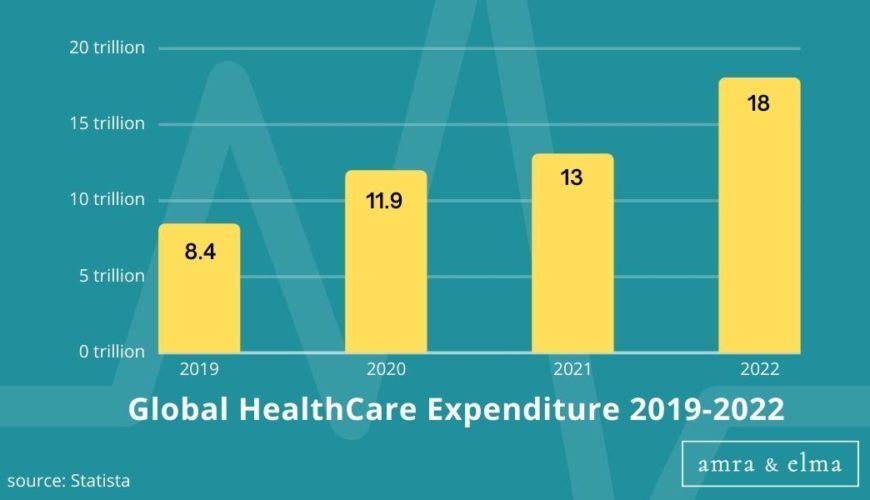
Healthcare Marketing Statistics #4: Projected figures indicate that healthcare spending in the United States will increase by 5% from 2023 to 2024, reaching a total of $4.9 trillion.
According to Centers for Medicaid and Medicare Services, the projected data suggests that healthcare expenditure in the United States is poised to rise by 5% between 2023 and 2024, amounting to a total of $4.9 trillion. When it comes to healthcare spending, the US is clearly at the top of the pack. These expenses encompass the costs associated with managing chronic or prolonged medical conditions, an aging demographic, and the rising expenses of novel medicines, procedures, and technologies. Additionally, healthcare reform legislation has widened access to insurance for millions of Americans. As medical advances are made, it is likely that this spending will continue to increase in the years to come.
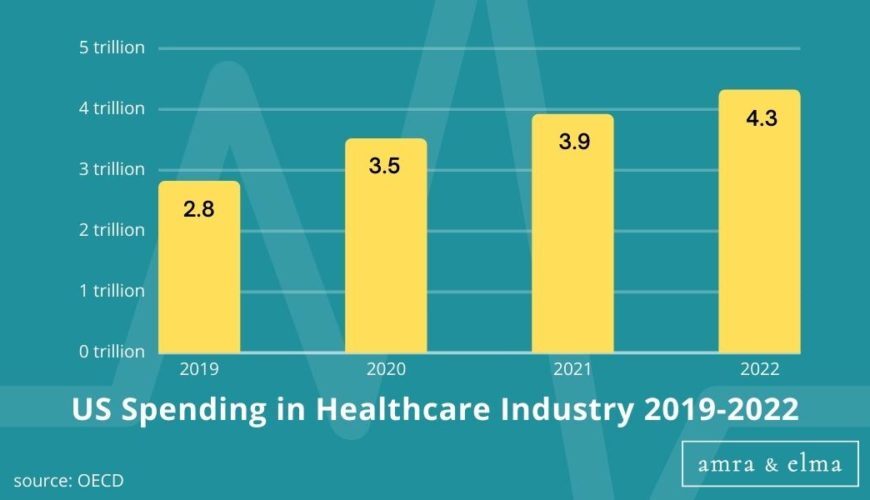
Healthcare Marketing Statistics #5: There are 784,626 companies in the US healthcare sector.
With healthcare spending in the United States expect to reach $4.9 trillion in 2024, it’s no surprise that the healthcare sector is home to a large number of companies. In fact, according to the latest industry stats by Statista, there are 784,626 companies in the US healthcare sector. Of these, McKesson is the largest by revenue. With annual revenue of $208.3 billion, it’s comfortably ahead of its nearest competitor, UnitedHealth Group, which reported revenue of $371.6 billion in 2023. Other names on the list include CVSHealth ($357.8 billion), AmerisourceBergen ($260 billion), and CardinalHealth ($205 billion). Collectively, these companies employ more than 15 million people in the United States.
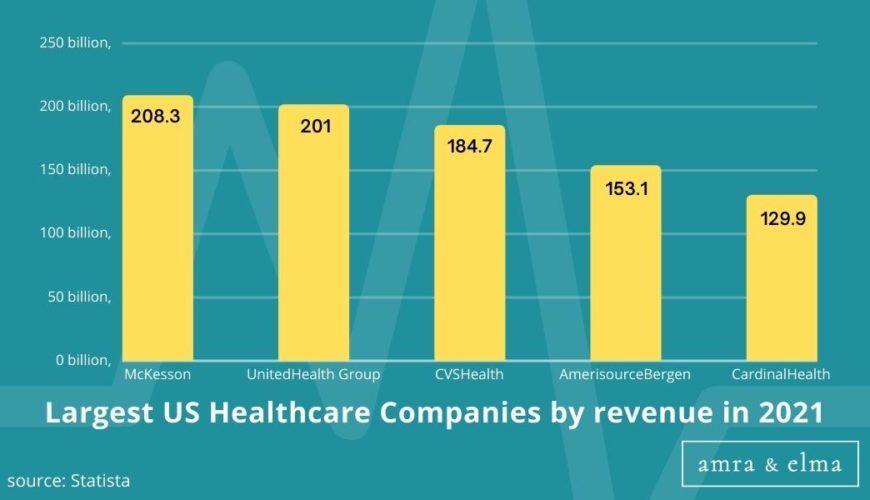
According to a recent Google search engine statistics report by 99firms, an estimated 7% of all search queries on the platform are health-related. This finding highlights the growing importance of online health resources in today’s digital age. With access to the internet becoming more and more widespread, people are increasingly turning to online platforms like Google for answers to their medical questions. As a result, companies and organizations that specialize in health information must have a strong online presence in order to meet the needs of their users. Whether providing up-to-date information on diseases and conditions or offering specialized tools such as symptom checkers and interactive quizzes, these platforms have become essential resources for anyone looking for reliable health information. Therefore, understanding this trend towards digital health literacy is crucial for ensuring continued success in the field going forward.
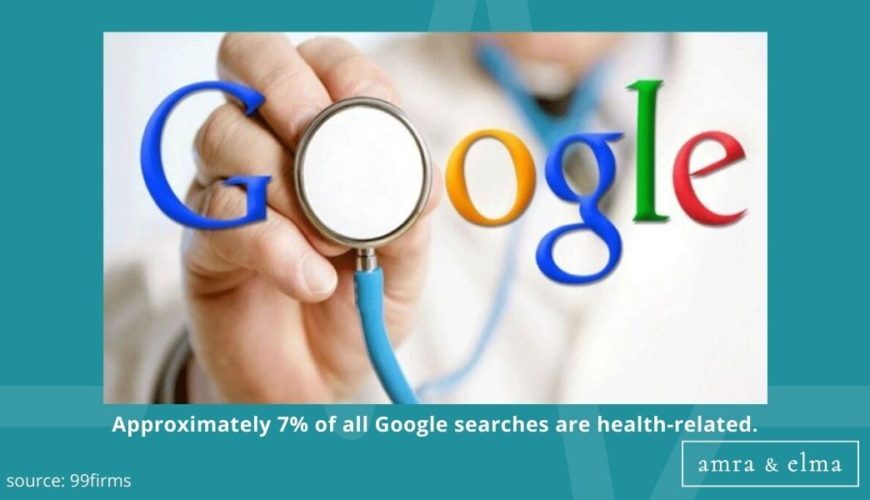
According to available data from Google Trends, over 70,000 health-related searches are made every minute, every day. These staggering numbers highlight the growing interest in health and wellness among consumers, and they also provide valuable insights for marketers seeking to target this audience.
To effectively capture the attention of health-conscious consumers, businesses need to understand what motivates these individuals and what their behavior looks like online. And by closely examining search data such as keyword popularity and search intent, it is possible to get a better sense of what consumers are looking for when they seek out information on health-related topics. With this information in hand, brands can craft more effective marketing campaigns that speak directly to the needs and desires of health-focused consumers. Ultimately, this will help companies reach their target audience more effectively and drive more significant sales and ROI across all market segments.
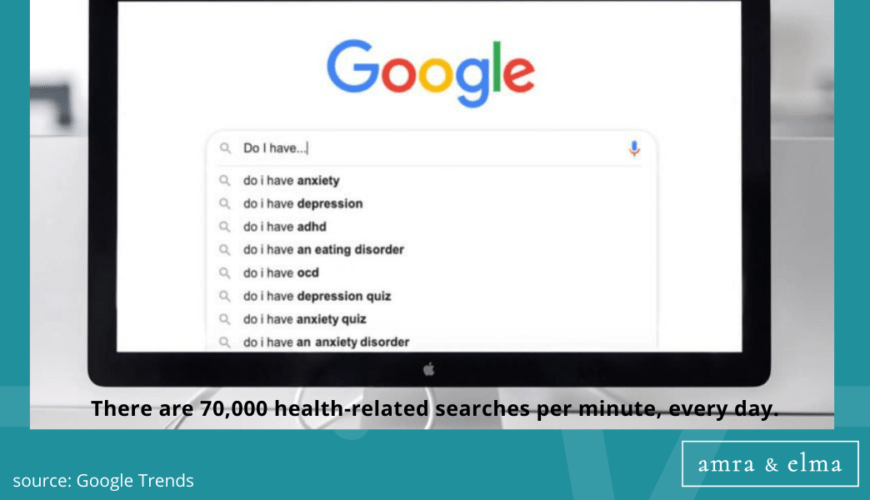
Healthcare Marketing Statistics #8: 82.8% of patients use search engines to find a healthcare provider.
A recent study found that 82.8% of US-based patients search engines to find a healthcare provider. The study, which the American Board of Internal Medicine conducted, surveyed 2,000 adults who had seen a healthcare provider in the past year. The results suggest that patients increasingly turn to the internet to research their healthcare options. Patients cited convenience, cost, and location as the most important factors when choosing a provider. However, the study also found that patients are often unaware of the providers’ credentials they find online. As a result, patients need to do their research before making an appointment. The American Board of Internal Medicine recommends that patients look for board-certified providers who have experience treating similar conditions. By taking the time to find a qualified provider, patients can be sure they are getting the best possible care.
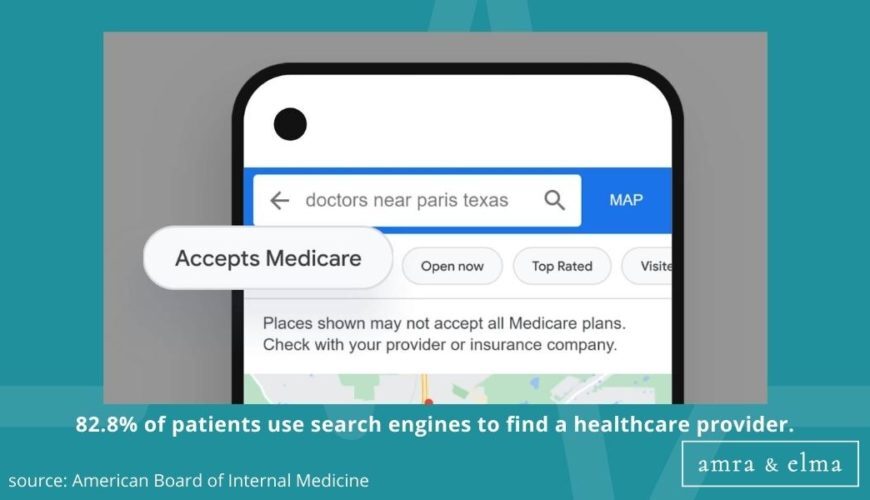
Healthcare Marketing Statistics #9: stanford study finds that 75% of patients reoly on online reviews as the first step to finding a doctor or healthcare provider.
According to a study conducted by Stanford, as reported by New York Times, the majority (75%) of patients depend on reviews as their initial approach when seeking a new doctor or healthcare provider. This shows that online reviews are extremely important in healthcare and that managing online reviews is helpful for a healthy online reputation as a healthcare practice.
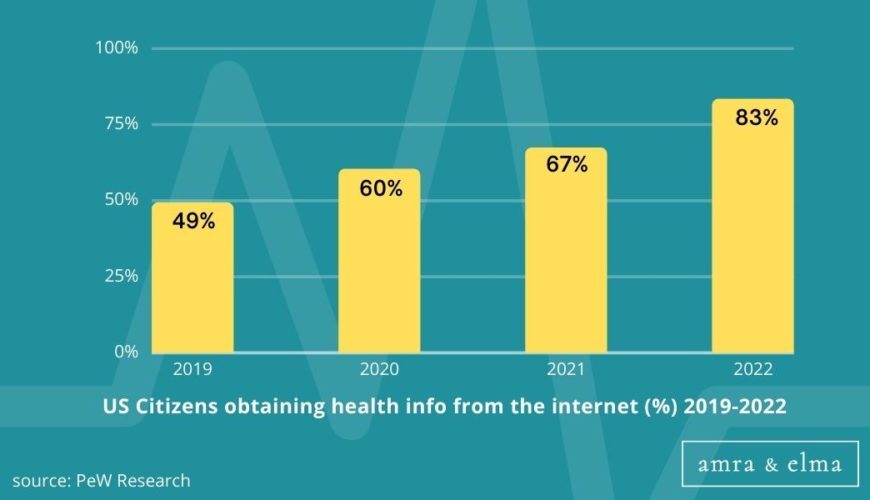
Healthcare Marketing Statistics #10: Only 24% of healthcare appointments in the US are scheduled online.
Although many healthcare appointments are now scheduled online, some patients remain reluctant to type their personal health information or reason for their appointment into an online form. According to a study by Accenture, 24% of healthcare appointments in the US are scheduled online. However, many patients are hesitant to provide their personal health information online due to concerns about privacy and security. In addition, patients may not be comfortable sharing their reason for seeking medical attention with strangers. As a result, some healthcare providers are still using paper-based scheduling systems. However, it is essential to note that online scheduling systems are typically more efficient and accurate than paper-based systems. In addition, online scheduling systems often allow patients to see the real-time availability of appointments, which can be a helpful feature for patients who need to schedule an appointment on short notice. For these reasons, more healthcare appointments will likely be scheduled online in the near future.
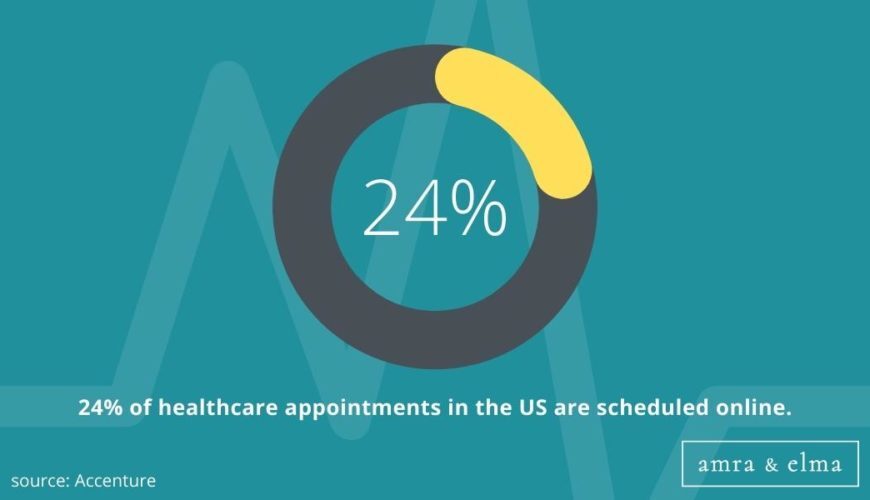
Healthcare Marketing Statistics #11: 89% of healthcare patients use online reviews to evaluate providers.
Online reviews are an important part of the healthcare landscape, as they provide a wealth of information to prospective patients evaluating providers. According to recent research from Software Advice, 89% of patients use online reviews when deciding which healthcare provider to choose, making them an essential tool for navigating the vast array of options available today. Reading these reviews can be an easy first step for prospective patients to get a feel for your practice, allowing you to connect with your target audience and engage potential new patients. At the same time, it is important to maintain a positive online presence through thoughtful comments and feedback from satisfied clients. With careful attention and diligence, you can take advantage of this powerful medium to position yourself as a top choice among potential patients.
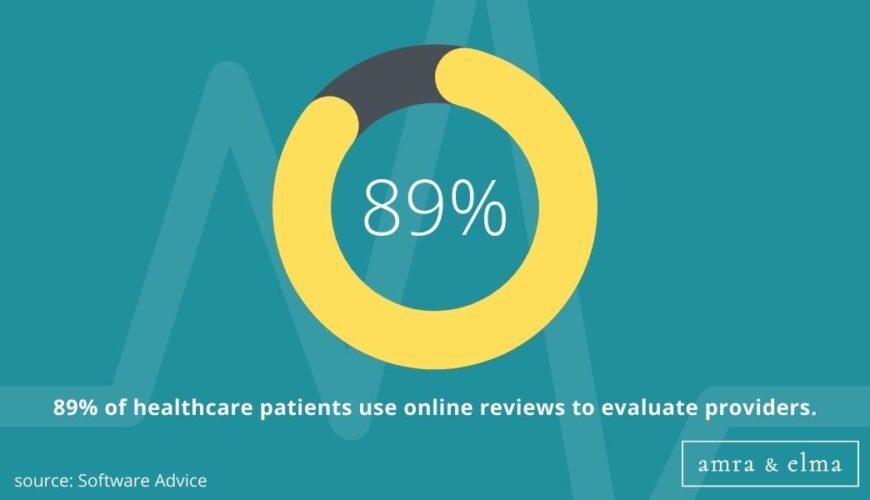
Healthcare Marketing Statistics #12: Over 71% of patients will search for another provider if there is not enough information on the website.
There is no denying the importance of having a solid digital presence in the healthcare industry. Patients nowadays depend so heavily on online resources to guide their search for medical providers. If a healthcare clinic or business lacks a website or other online presence, it will likely struggle to stand out from the competition. According to the data from WordStream, an estimated 60% of patients check that the clinic has a website before deciding whether or not to make an appointment. Moreover, 71% of patients say that they will look for another provider if there is no information regarding office hours and current services offered. Then, to remain competitive and successful in today’s healthcare landscape, healthcare businesses must invest in a robust and informative digital presence. By creating and maintaining a website, social media page(s), and other online platforms, healthcare businesses can give potential patients the information to feel confident in choosing their practice as their go-to healthcare provider.
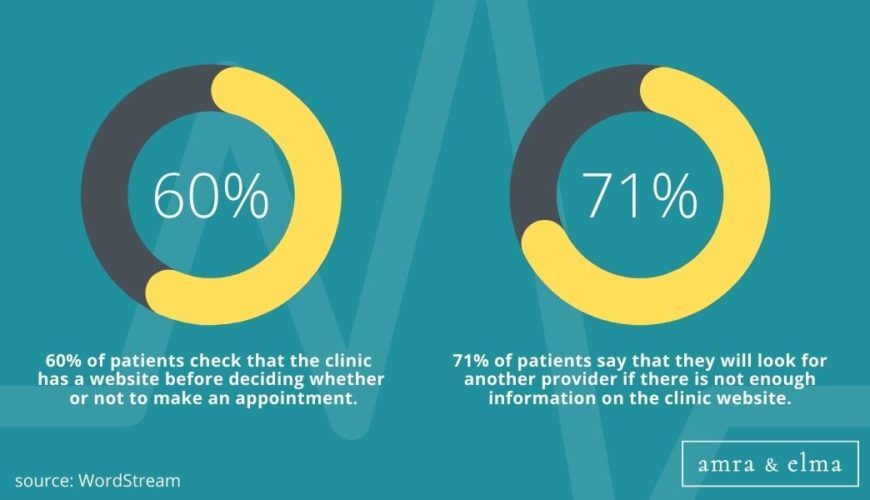
Healthcare Marketing Statistics #13: 63% of people choose healthcare providers based on the proximity to their home.
According to a report by WordStream, 63% of people choose healthcare providers based on the proximity to their home. This means that it’s important to leverage Location Targeting in ad campaigns and optimize for those local listings. Failing to do so could mean missing out on a large portion of potential customers. Additionally, it is important to make sure that company listing is accurate and up-to-date. Incorrect information could lead potential customers to choose a competitor over you. By taking these steps, you can ensure that you are reaching the maximum number of people possible.
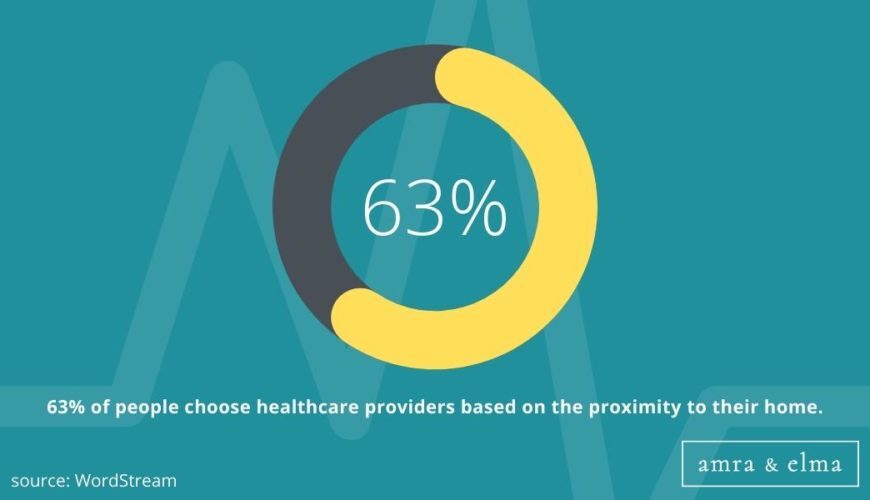
Healthcare Marketing Statistics #14: The average cost for a healthcare lead in 2024 will be $320 (CPL).
According to recent research by ZenithMedia, the average cost for a healthcare lead is expected to rise significantly in the coming years. According to estimates, the cost for a healthcare lead in in 2024 will be $320, up from from $286 in 2022, and up considerably from $209 in 2021, $195 in 2020, and $114 in pre-pandemic 2019. Several factors likely drive this trend, including rising digital ad spending and increased competition among healthcare marketers. In particular, as advertisers pour more money into digital advertising channels like social media and search engine marketing, the costs of acquiring quality leads increase. However, despite these challenges, the demand for high-quality leads remains strong across many industries. As a result, healthcare marketers must keep pace with fast-changing trends to meet these growing demands. By leveraging innovative strategies and targeting new audiences, they can ensure that their organizations stay competitive in this rapidly evolving landscape.
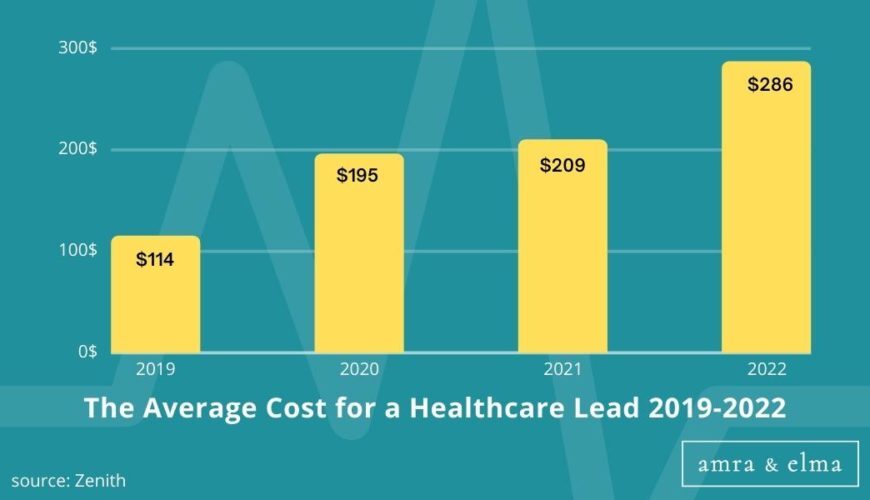
Healthcare Marketing Statistics #15: The average email open rate in the healthcare industry is about 21.5%.
The healthcare industry is constantly evolving to keep up with the latest research and technological advancements, making it an extremely competitive field. Effective marketing tactics are crucial for success in the healthcare industry, especially when it comes to email marketing. According to a recent report by Mailchimp, the average open rate for emails in the healthcare industry is about 21.5%. However, this number is somewhat deceiving, as the average click-through rate in this field is just 2.7%. While more people may be opening these emails than ever before, they are often quickly disregarded and ignored by recipients due to their low level of relevance and engagement.
To improve open email rates in the healthcare industry and increase click-through rates, it is essential to create relevant, engaging content that speaks directly to your target audience. This can involve using targeted subject lines that pique interest and communicate precisely what recipients will gain from reading your email. It can also mean delivering valuable content that provides actionable advice or useful information on topics relevant to your audience’s interests and needs. By tailoring your messaging and focusing on delivering real value to your subscribers, you can overcome the challenges presented by low engagement levels in e-mail marketing campaigns.
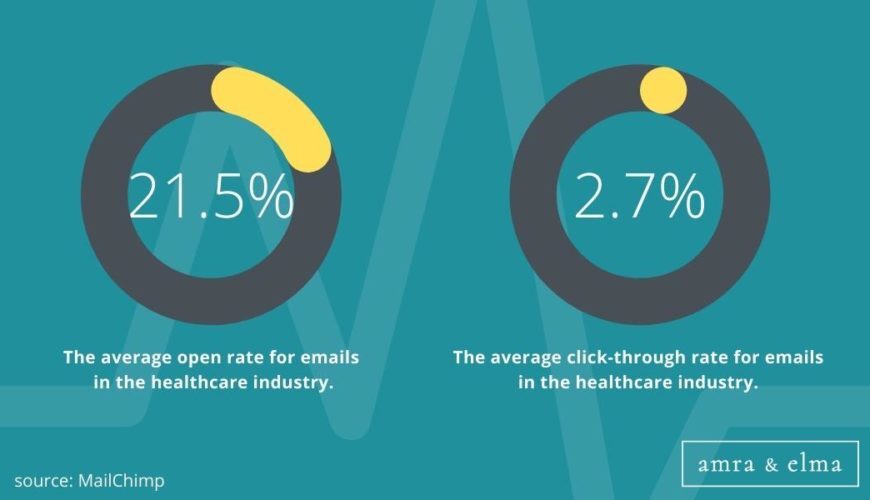
Healthcare Marketing Statistics #16: There are 350,000 healthcare and medical apps available on the Apple App Stores AS of 2023
According to a report from Statista, there are currently 350,000 mHealth applications available across various app stores. Specifically, the Google Play Store hosts approximately 54,546 healthcare and medical apps, while the Apple App Store offers around 41,517 healthcare and medical apps. These applications cover a range of categories, including medical, fitness, and health-related apps. The report also predicts continued growth in the healthcare industry, with the mHealth market size projected to increase from USD 63.88 billion in 2022 to USD 243.57 billion by 2030, reflecting a compound annual growth rate (CAGR) of 18.2% between 2022 and 2030..
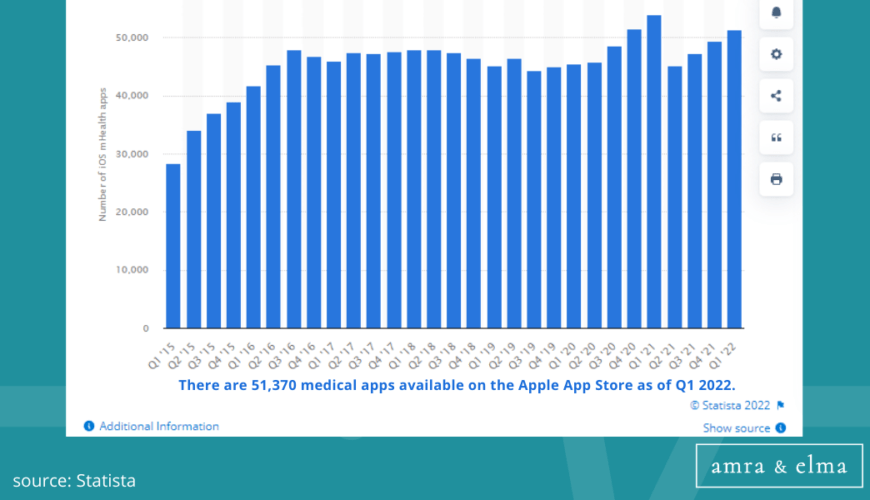
A study by the PwC Health Research Institute found that 43% of consumers would be willing to share their health data with companies in order to receive personalized service. This number is only expected to grow as people become more comfortable with digital health tools. The study also found that three-quarters of consumers are interested in using digital tools to track their health, and that half are interested in receiving real-time health coaching. These numbers suggest that there is a significant opportunity for companies to improve their customer service by harnessing the power of data. However, it is important to note that consumers are still concerned about data privacy, and that companies will need to address these concerns in order to build trust.
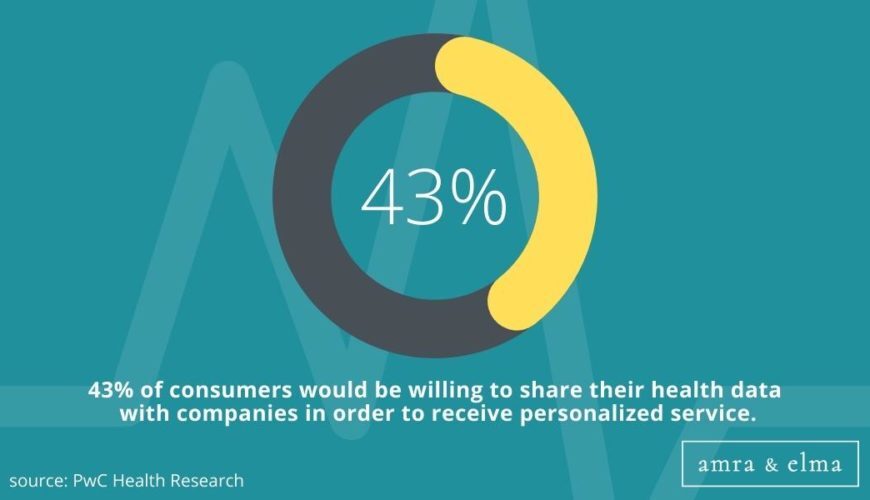
Healthcare Marketing Statistics #18: 60% of healthcare organizations plan to increase their use of artificial intelligence (AI) over the next three years.
When it comes to artificial intelligence, healthcare is leading the way. According to a recent report by McKinsey & Company, 60% of organizations plan to increase their use of AI within the next three years. The findings from this comprehensive survey indicate that the adoption of AI is on the rise, with 56% of respondents reporting current adoption in at least one function. The continued growth of AI in healthcare suggests that we are only beginning to tap into the full potential of this powerful technology, and it is clear that healthcare providers will be at the forefront of its advancement. With its ability to help streamline and automate key tasks, reduce costs and errors, and improve patient care outcomes, AI is already transforming healthcare as we know it. And with more and more organizations recognizing its value and investing in its development, we can be sure that the future of healthcare will be driven by AI.

Healthcare Marketing Statistics #19: Global Wearable Healthcare Devices Market Soars to USD 68.4 Billion by 2032 with 8.6% CAGR
According to Straits Research, In 2023, the global market size for wearable healthcare devices reached USD 32.5 billion. Projections indicate that by 2032, this figure is expected to rise to USD 68.4 billion, with a compound annual growth rate (CAGR) of 8.6% during the forecast period spanning from 2024 to 2032.
The burgeoning growth of the global wearable healthcare devices market underscores a significant shift towards personalized and accessible healthcare solutions. With a projected increase from USD 32.5 billion in 2023 to USD 68.4 billion by 2032, this market demonstrates substantial potential for innovation and expansion. The steady rise, anticipated at a compound annual growth rate (CAGR) of 8.6% from 2024 to 2032, highlights the increasing adoption of wearable technologies in healthcare management and monitoring. As wearable devices become increasingly integrated into daily life, they have the potential to revolutionize healthcare delivery by empowering individuals to take charge of their well-being and facilitating remote monitoring and diagnosis. Moreover, this growth trajectory signals opportunities for businesses to invest in and develop innovative wearable healthcare solutions that address evolving consumer needs and contribute to the advancement of healthcare outcomes globally.
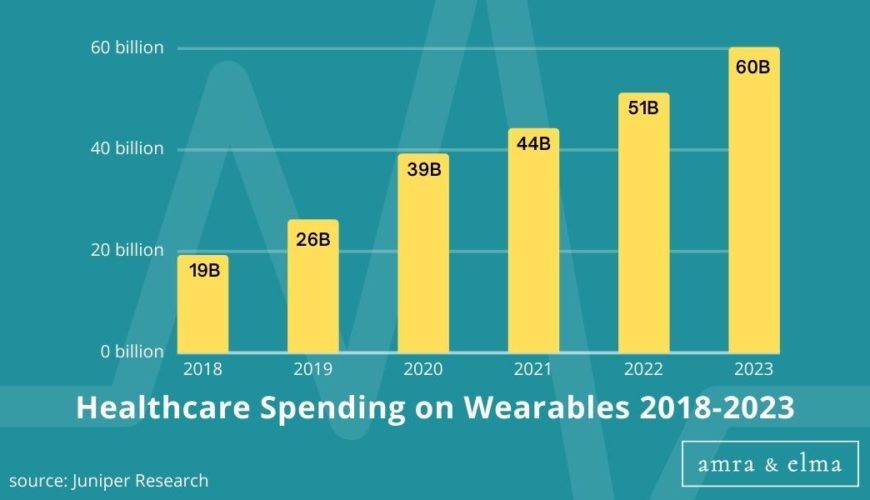
Healthcare Marketing Statistics #20: the number of connected wearables – the Market expected to Reach $173.7 Billion by 2030 from $32.5 Billion in 2022.
According to “Wearable Electronics – Global Strategic Business Report,” the global market for Wearable Electronics, estimated at US$32.5 Billion in 2022, is forecasted to expand significantly to US$173.7 Billion by 2030, reflecting a robust compound annual growth rate (CAGR) of 23.3% over the analysis period spanning from 2022 to 2030. Within this market, the Wristwear segment is anticipated to exhibit notable growth, with a projected CAGR of 21.6%, reaching US$89.2 Billion by the end of the analysis period. Similarly, the Eyewear segment is expected to experience substantial growth, with an estimated CAGR of 25.8% over the next eight years. This data underscores the accelerating adoption and demand for wearable electronic devices globally, driven by technological advancements and increasing consumer interest in personalized health and fitness monitoring. As the market continues to expand, opportunities for innovation and investment in wearable technology solutions are poised to flourish, shaping the future of healthcare, lifestyle, and digital connectivity.
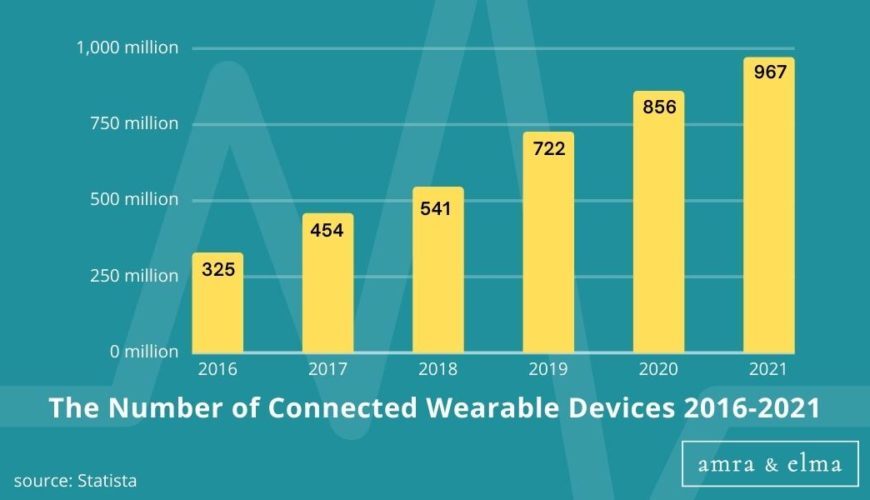
The Future of Healthcare Marketing
With these essential healthcare marketing statistics, marketers can stay informed of new developments in their industry and develop strategies that will help them thrive in 2023 and beyond. Whether you are considering entering the field or looking to keep up-to-date on the latest trends, it is essential to stay informed and know what is going on behind the scenes. Organizations can better connect with consumers across all channels, focusing on data-driven strategy and using technology to enhance their campaigns by taking advantage of these changes now on the opportunities and staying ahead of the competition.

